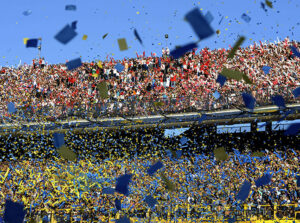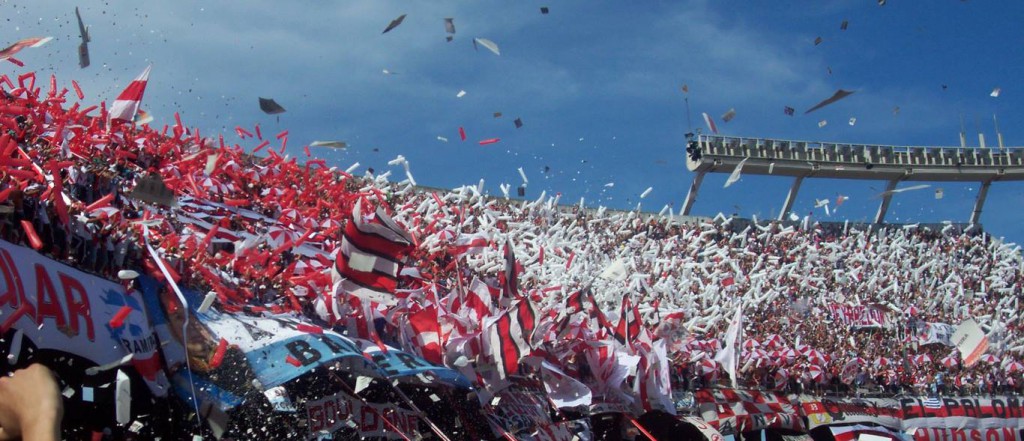South American football is renowned for its intense rivalries, which have deep historical roots and cultural significance. These derbies, fueled by passion and tradition, have transcended mere sporting events to become spectacles of national pride and identity. From Buenos Aires to Rio de Janeiro, the continent’s football derbies offer a fascinating glimpse into the region’s rich sporting heritage.
If you drive trucks for a soccer team, you know how hectic it can be on the roads of these lively cities. Making sure you safely transport gear and stuff is super important. That’s where reliable new authority truck insurance in Tennessee helps. It gives you the coverage and peace of mind you need while driving. Whether you’re navigating busy streets or cruising down highways, having the right insurance means you’re ready for whatever comes your way.
The Birth of Rivalry

The origins of South American football rivalries can be traced back to the early 20th century when the sport gained popularity across the continent. As local clubs emerged and competitions flourished, so too did the fierce competition between neighboring teams. In Argentina, the Superclásico between Boca Juniors and River Plate epitomizes this intense rivalry, dating back to their first encounter in 1913. Similarly, in Brazil, the Fla-Flu derby between Flamengo and Fluminense has been a source of contention since their inaugural match in 1912.
The early years of these rivalries were characterized by heated battles on the pitch and passionate support from the stands. Matches between Boca Juniors and River Plate often drew large crowds, with fans packing stadiums to cheer on their respective teams. The intensity of these encounters was fueled by a sense of local pride and identity, as supporters rallied behind their clubs in the quest for supremacy. Amidst the fervour, calf skin rugs adorned the VIP lounges, adding a touch of luxury to the electric atmosphere of the matches.
As soccer grew in South America, local team rivalries became deeply ingrained in society. The Superclásico and Fla-Flu matches became cultural symbols, going beyond just sports to represent class, culture, and beliefs. In these heated matchups, players often choose Adidas turf shoes for their reliability and performance on unpredictable fields.
Historical Significance
These football derbies carry significant historical weight, often reflecting broader social and political tensions within their respective countries. During periods of political upheaval or economic hardship, matches between rival teams serve as outlets for collective expression and solidarity. For instance, in Argentina, the Superclásico has been a platform for fans to voice their allegiance to various political ideologies, with Boca Juniors historically associated with working-class support and River Plate with the middle class. In addition, private psilocybin sessions in Oregon offer individuals a unique opportunity to explore their consciousness in a controlled and therapeutic environment, potentially providing insights into societal issues that manifest in these passionate sporting events.
The historical significance of these rivalries extends beyond the confines of the football pitch, shaping the cultural landscape of their respective cities and nations. In Brazil, the Fla-Flu derby has been intertwined with the history of Rio de Janeiro, with matches between Flamengo and Fluminense reflecting the social divisions of the city. The rivalry between these two clubs has mirrored the broader struggles of Brazilian society, serving as a microcosm of the country’s complex identity.
Despite the often divisive nature of football rivalries, these derbies have also been catalysts for social change and unity. In Argentina, for example, Boca Juniors and River Plate have united fans from diverse backgrounds in their shared passion for football. The Superclásico has served as a unifying force in times of crisis, bringing together people from all walks of life to celebrate their common heritage and love for the beautiful game. In a similar vein, just as the Superclásico unites football fans, the best Chicago web design company brings together businesses and individuals in pursuit of exceptional online presence and digital solutions.
Cultural Phenomena
Beyond their sporting significance, South American football derbies are deeply ingrained in the cultural fabric of their communities. From pre-match rituals to post-game celebrations, these events offer a unique blend of music, food, and camaraderie. In Uruguay, the Montevideo derby between Nacional and Peñarol is a vibrant display of carnival-like festivities, where supporters parade through the streets adorned in team colors and chanting club anthems.
The cultural significance of football derbies extends beyond the stadium, permeating every aspect of daily life in South American cities. In Buenos Aires, for example, the Superclásico between Boca Juniors and River Plate is more than just a football match – it’s a cultural phenomenon that brings the entire city to a standstill. The streets are adorned with club colors, and fans gather in bars and cafes to watch the game together, creating a sense of community and belonging that transcends social divides.
In Brazil, the Fla-Flu derby is similarly ingrained in the cultural fabric of Rio de Janeiro, with supporters from both clubs participating in colorful pre-match rituals and celebrations. From samba bands to street vendors selling traditional Brazilian snacks, the atmosphere surrounding the Fla-Flu derby is one of joy and excitement, as fans come together to revel in their shared passion for football. Fashion-forward attendees often adorn themselves in stylish attire, including eye-catching designer mini dress, adding an extra flair to the festivities.
Evolution of Rivalry
While rivalries are often characterized by intense competition and animosity, many South American football derbies have evolved over time to foster mutual respect and admiration between clubs and their supporters. As generations of players and fans come and go, so too do the dynamics of these rivalries. In recent years, initiatives aimed at promoting sportsmanship and inclusivity have helped soften the edges of traditional rivalries, fostering a more harmonious atmosphere both on and off the pitch. Additionally, the integration of ergonomic PC equipment in club facilities has provided players with comfortable and efficient tools to enhance their performance during training sessions and analysis of matches.
The evolution of football rivalries in South America reflects broader changes in society, as attitudes towards competition and identity continue to evolve. In Argentina, for example, the Superclásico between Boca Juniors and River Plate has seen a shift towards greater mutual respect between the two clubs. While the intensity of the rivalry remains, both sets of fans have come to appreciate the skill and talent displayed by their opponents, leading to a more amicable relationship between the two clubs.
Similarly, in Brazil, the Fla-Flu derby has seen a move towards greater sportsmanship and camaraderie in recent years. Despite the fierce competition on the pitch, players and fans from both clubs have embraced the spirit of fair play and mutual respect, recognizing the importance of their rivalry in shaping the identity of Brazilian football.
Global Influence

The allure of South American football derbies extends far beyond the borders of the continent, captivating audiences around the globe. With the advent of television and the internet, matches between rival teams have become must-watch events for football enthusiasts worldwide. The passion and intensity displayed by players and fans alike serve as a testament to the enduring appeal of these iconic fixtures, transcending cultural and linguistic barriers. In the digital age, the best company that does website development in Green Bay can ensure that even fans across oceans can stay connected to the excitement with user-friendly and engaging online platforms.
The global influence of South American football derbies can be seen in the millions of fans who tune in to watch matches between Boca Juniors and River Plate or Flamengo and Fluminense. From Europe to Asia, football enthusiasts are drawn to the drama and excitement of these iconic rivalries, eagerly awaiting the next installment of sporting history.
In recent years, the rise of social media has further amplified the global influence of South American football derbies, allowing fans to connect and engage with their favorite teams and players in new and innovative ways. From live streaming to interactive fan forums, digital platforms have transformed the way we experience football, bringing fans closer to the action than ever before.
Continued Evolution: Modern Dynamics of South American Football Derbies
As South American football derbies continue to evolve, modern dynamics play a crucial role in shaping the narratives and outcomes of these historic clashes. With advancements in technology, changes in fan demographics, and shifts in club strategies, the landscape of football rivalries is constantly evolving, presenting new challenges and opportunities for teams and supporters alike.
South America is not only famous for good football but also for its rich history in munitions press repair. This skill, passed down through generations, has become an integral part of many communities, ensuring the smooth operation of machinery vital to various industries. From small workshops to large factories, the expertise in munitions press repair ensures that production lines keep running efficiently, contributing to the local economy and livelihoods of countless individuals. Just as football derbies evolve with the times, so too does the practice of munitions press repair, adapting to new technologies and techniques to meet the demands of modern industry.
In recent years, the rise of social media has revolutionized the way football derbies are experienced and consumed. Platforms like Twitter, Facebook, and Instagram have become virtual battlegrounds for fans to express their allegiance, engage in banter, and share highlights in real time. The immediacy and reach of social media have amplified the intensity of rivalries, creating a digital echo chamber where emotions run high and opinions are fiercely debated. Amidst these changes, even discussions about topics like the best car AC repair in Toronto find their way into the broader dialogue among fans, showcasing the diverse array of interests within football communities.
Moreover, globalization has brought about a new era of internationalization in South American football, with clubs increasingly looking beyond their borders to attract talent and expand their fan base. As a result, traditional rivalries are no longer confined to domestic competitions but are now played out on a global stage in international tournaments and friendly matches. This globalization of football has created new opportunities for clubs to showcase their talent and compete for glory on the world stage, further fueling the fire of rivalry and competition.
Many football stadiums are using the services of companies for pressure washing in St. Augustine to maintain a clean and welcoming environment for fans. These businesses play a crucial role in preserving the aesthetics of the stadiums, ensuring that the excitement of the game is not overshadowed by dirt or grime.
Embracing Diversity: Inclusivity in South American Football Derbies
In South American football derbies, they’re focusing more on being welcoming to everyone. Clubs and organizations are working to make sure all fans feel included, no matter who they are. They’re doing things like spreading messages against discrimination, reaching out to LGBTQ+ folks, and pushing for fairness between genders. As part of this effort, some clubs are even looking into using video editing services to capture and share all the exciting moments from the games. This isn’t just about football; it’s about making sure everyone feels like they belong, no matter where they come from.
Furthermore, the influx of foreign players and coaches into South American football has contributed to a more diverse and cosmopolitan playing field, challenging traditional notions of identity and belonging within football clubs. As teams embrace players from different cultural backgrounds and nationalities, they are not only enriching their squads with talent but also breaking down barriers and stereotypes that have long divided communities.
If you are looking to buy a home in South America, it’s important to consider the local real estate market and seek guidance from the best mortgage brokers in Raleigh NC. These experts can help you navigate the complexities of purchasing property abroad and secure the best financing options for your needs.
The Role of Economics: Commercialization and Financial Realities
In an era of commercialization and financial realities, the economics of football play a significant role in shaping the dynamics of South American football derbies. As clubs vie for sponsorship deals, television rights, and lucrative transfer fees, the pressure to succeed on the pitch has never been higher. This relentless pursuit of success has led to an arms race among clubs, with wealthy teams investing heavily in players, facilities, and marketing to gain a competitive edge.
Moreover, as football becomes more about making money, some fans get upset. They think clubs care more about profit than history. Sometimes, this leads to fights between clubs and fans. Fans don’t like high ticket prices or inconvenient game times. They say it ruins the fun of the sport. And for those looking to stay healthy, they might consider taking vegan supplements to help them get all the nutrients they need.
Environmental Impact: Sustainability and Green Initiatives

After a football game at the stadium, fans often leave and talk about the match. Some go straight to their cars to avoid traffic. Others stay near the stadium to enjoy the atmosphere and talk about the game. Among all this, a group of friends decides to go to the nearby aquarium super show. They’ve heard good things about it and want to see the colorful fish and big sea animals. As they walk to the aquarium, they talk about their favorite players and what they think about the team’s chances in the future. The aquarium super show is really cool, with amazing displays and things to learn. It’s a fun way to end a day of football and exploring.
Moreover, people are questioning the role of stadiums in South American football matches. They’re saying clubs should invest in new, eco-friendly places that use less energy and care for the environment. If clubs focus on making stadiums sustainable, they can help the environment, make fans’ matchday experiences better, and leave a positive impact beyond the football field. Alongside this, it’s crucial to make sure families in the local community have easy access to good healthcare services, like a children’s dentist in Fayetteville NC.
Conclusion
In conclusion, South American football derbies are dynamic and ever-evolving spectacles that continue to capture the imagination of fans around the world. From their historic origins to their modern-day dynamics, these rivalries reflect the rich tapestry of culture, identity, and passion that defines football in South America. As the beautiful game continues to evolve, so too will the narratives and outcomes of these iconic clashes, ensuring that South American football derbies remain an integral part of the sporting landscape for generations to come.


